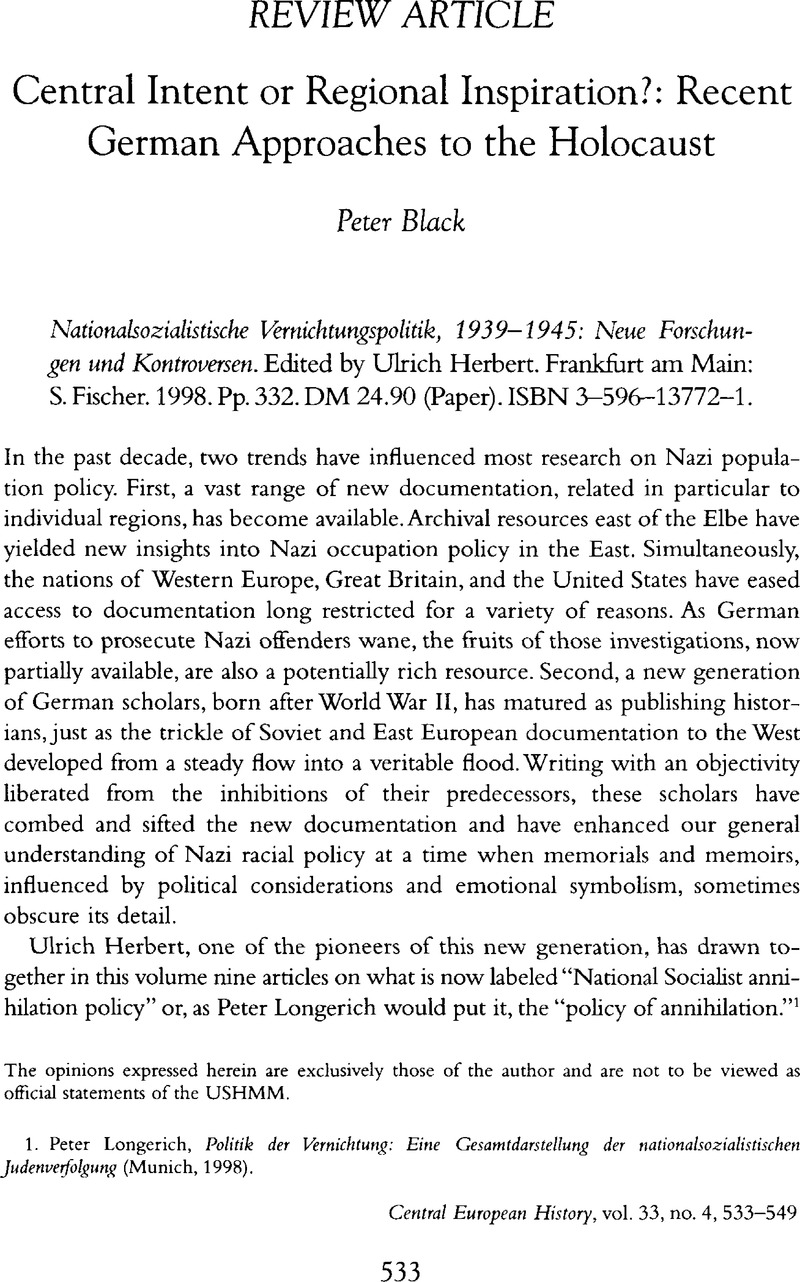Published online by Cambridge University Press: 16 December 2008

1. Peter, Longerich, Politik der Vernichtung: Eine Gesamtdarstellung der nationahozialistischen Judenverfolgung (Munich, 1998).Google Scholar
2. Eberhard, Jäckel, Frankreich in Hitlers Europa: Die deutsche Frankreichpolitik im Zweiten Weltkrieg (Stuttgart, 1966)Google Scholar; Hans, Umbreit, Deutsche Militärverwaltungen 1938'1939: Die militärische Besetzung der Tschechoshwakei und Polens (Stuttgart, 1977).Google Scholar
3. Jens, Banach, Heydrichs Elite: Die Führerkorps der Sicherheitspolizei und des SD 1936–1945 (Paderborn, 1998), 49, 68, 79, 80Google Scholar. These findings regarding academic success or at least pretension firm up my own rather unscientific conclusions based on education levels and social background of the office chiefs of the Reich Central Office for Security. See Peter, Black, “Well-Educated Killers,” paper given at the Lessons and Legacies Conference in Boca Raton, November 1998.Google Scholar
4. Herbert, Ziegler, Nazi Germany's New Aristocracy: The SS Leadership, 1925–1939 (Princeton, 1989), 114–15.Google Scholar
5. Bernd, Wegner, Hitlers Politische Soldaten: Die Waffen SS, 1933–1945, Leitbild, Structure und Funktion einer nationalsozialistischen Elite (Paderborn, 1990, 4th ed.), 227.Google Scholar
6. Götz, Aly, “Final Solution”: Nazi Population Policy and the Murder of the European Jews (New York, 999).Google Scholar
7. Frank, Golczewski, “Polen” in Dimensionen des Völkermords: Die Zahl der jüdischen Opfer des Nationahozialismus, ed. Wolfgang, Benz (Munich, 1991), 448–57.Google Scholar
8. Memorandum of OKW Operations Staff, signed Warlimont, re: Treatment of Captured Political and Military Functionaries, 12 May 1941, Document 1471–PS, in Anatomie des SS-Staates (Munich, 1967), 2:179–80.Google Scholar
9. Peter, Witte et al. , eds. Der Dienstkalender Heinrich Himmlers, 1941/42 (Hamburg, 1999)Google Scholar, entry for 20 April 1942 (and n. 60), 405.
10. Since this review essay was drafted, an English translation of Herbert's volume has appeared with a slightly modified title: National Socialist Extermination Policies: Contemporary German Perspectives and Controversies (New York, 2000)Google Scholar. The Browning article was dropped from the English edition and excellent articles by Sybille, Steinbacher (“In the Shadow of Auschwitz: The Murder of the Jews of East Upper Silesia”)Google Scholar and Karen, Orth (“The Concentration Camp SS as a Functional Elite”)Google Scholar have been added. What I have written in general applies to the Steinbacher article. The Orth article, which, like the Browning article that it replaced, seeks in part to deal with motivation for individual killers, but, like the Browning article is an uneasy fit in this collection.
11. Goldhagen, Daniel J., Hitler's Willing Executioners: Ordinary Germans and the Holocaust (New York, 1996), 534Google Scholar n. 1, 547–48 n. 31, 32, 551 n. 65, 580 n. 22, 582 n. 35. See also Goldhagen's review of Browning's 1992 publication Ordinary Men, in New Republic 207, nos. 3 and 4 (1992): 49–52.Google Scholar
12. Wirtschaftsstab, Ost, Gruppe, La[ndwirtschaft], “Wirtschaftspolitische Richtlinien für Wirtschaftsorganisation Ost, Gruppe Landwirtschaft,” 23 May 1941Google Scholar, Document 126–EC, International Military, Tribunal, The Trial of the Major War Criminals, 42 volumes (Nuremberg: 1947), vol. 36, 135–57Google Scholar, here 140.
13. In his book, Gerlach is more cautious in presenting his conclusions and concedes that the decision-making process in the German agencies at the center regarding genocide are “by far not yet sufficiently researched.” See Christian, Gerlach, Kalkulierte Morde: Die deutsche Wirtschafts- und Vernichtungspolitik in Weissrussland 1941 bis 1944 (Hamburg, 1999), 1161.Google Scholar
14. Omer, Bartov, “The Lost Cause” (Review of Götz Aly's “Final Solution”), New Republic, 4 (10 1999): 52.Google Scholar
15. Christopher, Browning, The Path to Genocide: Essays on Launching the Final Solution (Cambridge, 1992), 114.Google Scholar